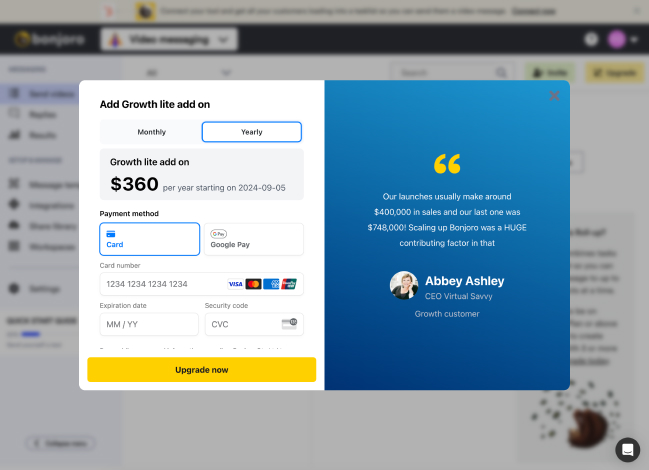Canva, founded in Australia in 2012, has revolutionized digital design. This tech unicorn offers an simple platform for creating everything from social media graphics to work presentations.
In just over a decade, Canva has soared to an incredible A$40 billion valuation, with over 170 million active users worldwide. But what's the secret behind this meteoric rise?
Their valuation isn't just based on hype; they're generating serious revenue, with projections reaching an estimated $2.7 billion in 2023. Canva's intuitive product and vast template library definitely laid the critical foundation, but it’s their ingenious paywall strategy is what truly unlocked their earning potential. Money doesn't just magically appear in their bank account (or grow on trees), Canva leads their free users through a meticulous payment conversion funnel that they've been perfecting over years.
Canva's paywalls don't just act as a barrier — it's a conversion miracle, finely tuned to guide users from free to premium.

Lets break down every little thing that Canva does differently so you can apply it to your own business
The Little Crown
Canva’s crown icon is more than a pretty picture — it’s a powerful psychological trigger. This tiny symbol appears next to all premium features, creating an irresistible allure. It’s like a "VIP" sign in the digital design world, subtly reminding free users of what they’re missing.

Visually distinctive without being intrusive, it is consistently applied across the platform. This creates a clear hierarchy between free and premium features.
Plan-Specific Feature Highlights
Unlike companies that overwhelm users with a confusing array of plans, Canva takes a smarter approach. When you try to access a premium feature, Canva doesn't bombard you with four different plans to choose from. Instead, it shows you exactly the right plan that includes the feature you need.

This targeted strategy eliminates the "oopsie" moment many users experience when they realize they've chosen the wrong plan for their needs. Canva's system is designed to understand which feature you're attempting to use and then present you with the most appropriate upgrade option.
Preview Future Success
Canva doesn't just tell you about premium features—it shows you your potential future. When you encounter a paywall, Canva presents a vivid preview of the feature you're trying to access, demonstrating it in action as if you've already upgraded.

But Canva takes it a step further. Alongside the feature preview, you might see a success story of a user similar to you who upgraded and achieved their goals. For instance, if you're trying to access advanced branding tools, you might see a small business owner showcasing their polished brand kit and describing how it boosted their professional image.
This clever strategy accomplishes two things:
It gives you a "hands-on" feel for the premium feature, creating a "try before you buy" experience without giving everything away.
It helps you "think past the sale" by visualizing your own success after upgrading.
Eliminating Risk
Canva's "Try Free for 30 days" offer isn't just a trial - it's a masterclass in user conversion and retention. This seemingly simple proposition packs a powerful psychological punch.

While they do collect credit card information upfront, the allure of a risk-free month proves irresistible. This critical 30-day window allows users to integrate Canva into their workflow, achieving tangible results before any billing happens. Users get to enjoy a seamless premium experience, uninterrupted by any more paywalls.
But here's the clever part: as users create with premium features, they unwittingly build their own golden handcuffs. Cancel, and they lose access to these creations - a prospect few can stomach after experiencing Canva's full potential. Gentle reminders near the trial's end serve as a final nudge, highlighting the value gained and the potential loss.
This strategy transforms the traditional paywall from a barrier into an irresistible invitation. By the time the trial concludes, Canva has become indispensable to many users, who gladly transition to paying customers.
User Experience Mastery
Canva’s paywall isn’t just about what features are offered—it’s about how they’re presented. The user experience (UX) is crafted with precision, ensuring a smooth journey from free user to paid subscriber.
The Power of Context
Canva's paywall strategy is a masterclass in maintaining user focus and momentum. Unlike competitors who redirect users to separate pricing pages or external checkout processes (we're looking at you, Stripe), Canva keeps everything right where you are - in a sleek, unobtrusive modal.
This approach is genius in its simplicity. When you hit a paywall, you're not whisked away to a confusing list of plans or, worse, an entirely different website. Instead, a modal pops up, offering the exact upgrade you need without losing sight of your work. The entire process - from feature preview to card entry and checkout - happens right there, in context.
The benefits are profound. Users remain engaged with their task, reducing the chance they'll reconsider or get distracted. The immediacy of the process keeps decision-making momentum high, significantly boosting conversion rates.
But there's an added bonus for Canva: this method provides crystal-clear data on which features drive upgrades. By tying each paywall interaction to a specific feature, Canva gains invaluable insights into user behavior and preferences.
Brand Consistency
Canva's paywall isn't just a checkpoint—it's a brand experience. From the signature purple-and-white palette to custom fonts and playful icons, every element reinforces the Canva identity. This consistency isn't mere aesthetics; it's a strategic approach to building trust and driving conversions.
By maintaining brand cohesion from product to payment, Canva amplifies user trust and boosts perceived value. The seamless, in-house payment flow eliminates jarring third-party redirects, reducing drop-offs and increasing conversion rates.
Canva transforms a potential friction point into a brand-strengthening, trust-building engine. It's not just a payment process; it's a master class in user-centric design that pays dividends in both revenue and loyalty.
Seamless Transitions
Canva’s interface flows like a well-designed presentation. As users explore different features or pricing options, the transitions are smooth and intuitive.

Subtle animations guide the eye from one section to the next. Information is presented in a sequence that mirrors the user’s decision-making process. Complex information is revealed gradually to avoid overwhelming users, ensuring logical flow.
By mastering these UX elements, Canva turns the potentially jarring experience of hitting a paywall into a natural part of the user journey. This seamless integration of the paywall into the overall user experience is a key factor in Canva’s impressive conversion rates and user satisfaction.
Social Proof
Canva doesn’t just show off its features—it showcases its users’ triumphs. This celebration of user success is a crucial part of their paywall strategy, leveraging social proof to drive conversions.
Canva employs the "Before and After" technique, showcasing targeted testimonials and micro-commitments to build momentum and demonstrate progression.

Detailed case studies and industry-specific showcases provide blueprints for success, quantified with hard numbers to illustrate ROI.
Canva’s social proof strategy is a masterclass in creating a sense of belonging and aspiration. By showing success stories of users who share similar identities or goals, Canva makes the decision to upgrade feel like a natural next step in their own success story.
Conclusion
Canva’s approach to paywalls is a masterclass in how to balance free and premium offerings, leveraging UX, personalization, and social proof to drive conversions and fuel impressive growth.
Inspired by Canva's strategy? Plandalf lets you build similar high-converting checkout flows — no engineers required.
Design in Figma, launch in minutes
A/B test with ease
AI-powered insights
Zero code deployments

Ready to boost your conversions? Join our waitlist and start your paywall revolution.
Plandalf: Where Canva-inspired paywalls meet your business needs.
